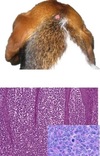Final- Integument Flashcards
Vesicle/Bulla
• Palpable elevation filled with clear fluid( fragile and they don’t stick around for long)
Degeneration and Necrosis or Inflammation and Repair
NAME DEPENDS ON SIZE:
– Vesicle < 1cm
– Bulla > 1cm
Causes:
– Auto‐immune dermatoses
– Viral infections
– Chemical irritants
– Burns

What can lead to the formation of vesicle/bulba?
- Intercellular edema ( histologically called “spongiosis”)- inflammatory process
- Intracellular edema (“hydropic degeneration”- loose osmotic balance)
- Disruption of intercellular junctions (“acantholysis”)
How vesicles form
Fig. 17‐17 Schematic diagram of the sites of vesicle formation in the skin. A, In a subcorneal vesicle, the stratum corneum forms the roof of the vesicle (as in impetigo or pemphigus foliaceous). B, In a suprabasal vesicle, a portion of the epidermis (stratum spinosum) forms the roof (as in pemphigus vulgaris). C, In a subepidermal vesicle, the entire epidermis separates from the dermis and forms the roof (as in bullous pemphigoid).
Need to know– you can get a lot of information by knowning where the vesicle is forming- SAMPLE IT

Pustule
Palpable elevation filled with pus
Cause – leukocyte infiltrate
Pathological process: Inflammation and Repair
I.e. Pimples

Crust
can be when a pustule ruptures
• Dried exudate, serum, blood, and scale that is adhered to the skin surface
Causes:
– Severe disorders of keratinization
– Severe pustular dermatitis( when pustules burst)
– Secondary to ulcers
Pathological Processes: Degeneration/Necrosis, Inflammation/Repair, or Disorder of Growth

Papules
• Palpable, solid (no fluid), elevated mass < 1cm diameter
i.e. mosquito bite
Causes:
– Infiltrate of inflammatory cells
– Infiltrate of neoplastic cells
– Epidermal hyperplasia
– Deposit of mineral
Termed Based on Size:
Nodules = >1cm diameter and deeper- usually thinking about tumors
Plaques = coalesced papules- has a flat surface
Pathological Process: Inflammation/Repair, Disorder of Growth, Deposits and Pigmentations


Plaque- solid but with a flat top

Nodule
Ulcers
• Loss of epidermis with exposure of dermis- VERY NON-SPECIFIC
Cause: 2ndaryto…
– Epidermal necrosis
– Inflammation
– Infarction(cut off of blood supply)
– Neoplasia
Pathological processes: degeneration/necrosis, inflammation/repair, cirulatory disorders, or disorder of growth
Erosion— no dermis exposed

Scale
• Accumulation of loose keratinized cells
- dandruf
Causes:
– Disorders of keratinization
– Chronicdermatitis
Pathological Process: Inflammation/Repair or Disorders of Growth

Epidermal collarette
a circular rim of scale that occurs secondary to rupture of a vesicle, pustule, or papule
FORM OF SCALE- vesicle, papule or pustule has ruptured

Lichenification
• Thickening and hardening of the skin
- becomes hyperpigmented
Causes:
– Chronic irritation/inflammation
Pathological Process: Inflammation and Repair

What lesion terms can we use here?

- ulcers
- erthyema (skin term ONLY)
- paules
When collecting a skin biopsy…
• DO
– Biopsy early, before treatment
– Be gentle
– Collect multiple samples, range of changes – Include crusts
• DO NOT
– Surgically prep the site
– Grasp with forceps
– Biopsy the center of a lesion
– Hold out on history/DDx
Pathological Processes of degeneration and necrosis
Can be difficult to grossly tell from other groups
- Degenerative/Necrotic lesions tend to ulcerate, but other pathological processes lead to ulceration too
- Degenerative/Necrotic lesions become inflammation&repair over time – normal response to injury, and secondary infections common
- Primary circulatory disorders often lead to degeneration/necrosis
THINCK BURNS
Flock of 300 merino ewes& lambs in the shade cuddling after a period of a lot of rainfall.

The skin lesions indicate something is injuring the epidermis because there are crusts and ulcers
The pathological process is likely epidermal degeneration&necrosis or inflammatory (infectious)
Differential Diagnoses
• Photosensitization
• Dermatophilus
• Viral infections – bluetongue, pox (orf), vesicular disease (FMD, VS
What can we do to determine the cause?
BIOPOSY, serum chem(NSF), bluetongue (negative), virus isolation(negative), plant id- st. john’s wort, histopath results- epidermal necrosis and ulceration(unknown etiology) comment- bacterial dermatitis which appears secondary

Pathogenesis of Photosensitization
Uv light absorbed by photodynamic chemicals(shouldn’t be there) in skin causes free radical damage causes e_pidermal necrosis of lightly pigmented or sparsely haired skin_
2 Types of Primary photosensitization
Primary photosensitization
_Type I (Exogenous)_ – Plants containing photosensitive chemicals
– St Johns Wort, lucerne, perennialryegrass
-TMS, quinolones, griseofulvin
Type II (Intrinsic)
– Porphyria
– Inherited deficiency of proporphyrinogen III cosynthetase leads to defect in heme synthesis leads to buildup of porphyrins(PINK TEETH)
Secondary Photosenitization
Pathogenesis of Photosensitization
Light activates agents leads to free radical damage leads to epidermal necrosis of lightly pigmented or sparsely haired skin
Secondary (Type III, hepatogenous photosensitization)
– Poor hepatic clearance of phylloerythrin (product of rumenal chlorophyll transformation).
– Toxins causing biliary obstruction: nothing in these plants- phylloerythrin just can not clear the liver
• Lantadenes – Red Lantana
• Steroidal saponins – Tribulus, Pancium
- Sporodesmin (Facial Eczema) ‐ Lolium perenne + Pithomyces chartarum—>sporodesmin toxicosis
- Other hepatotoxins: Pyrrolizidine alkaloids, aflatoxin, phomopsin

Liver from a sheep with photosensitization due to red lantana toxicosis
REMEMBER- THE LIVER CAN BE NORMAL

Liver from a sheep with photosensitization due to Tribulus toxicosis
A couple learning points
- Important to use clinical clues to come up with differentials for likely pathological processes of skin pathology
- Not always going to get definitive answers from your tests, including histology (gasp!)
- How did we rule out type III photosensitization in this case?
We found the plant and we did a serum chemistry(if it was type III, then hyperbillirubia should show up)
• How do we know this simply wasn’t just too much sun exposure (i.e. not photosensitization)? History is different; photosensitization happens a lot faster
Most Degeneration&Necrosis skin cases have these features…
pink storm= necrosis

Skin healing by primary and seconary intention



























































































































